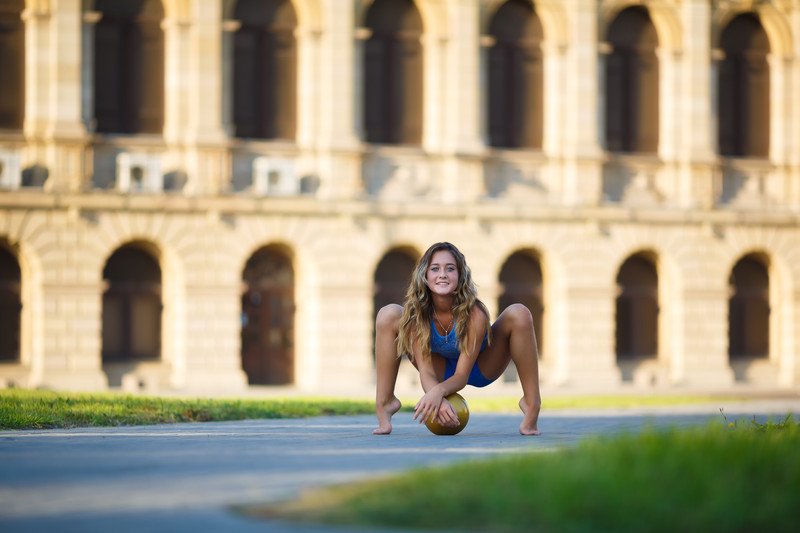Rhythmic gymnastics uses ropes, hoops, balls, clubs, or ribbon accompanied by music on the floor. The event is for women-only and can be performed by individuals or groups. Rhythmic gymnastics started over 3,500 years ago in ancient Egypt and were a celebration of the female human form.
During this time, aesthetic expression in the human form was encouraged. Shortly after, the beauty of human form expression became something to be sought after. Evidence of rhythmic gymnastics can be found in ancient tombs, graves, Egyptian pottery, and even some of the pyramids.
Ancient Egyptians Were the Earliest Gymnasts
Ancient Egyptians were the world’s earliest gymnasts. Artifacts have shown young women with spheres working in group exercise just like traditional rhythmic gymnasts do today. However, these events were more recreational and not competitive.
While not all sports historians agree on exactly when rhythmic gymnastics began, everyone does agree that the Ancient Egyptians shaped this form of physical expression.
Rhythmic Gymnastics Wasn’t Recognized until 1962
Despite being in existence for thousands of years, the International Gymnastics Federation (FIG) didn’t recognize sport until 1962. The first World Championships for this activity were held in 1963.
The first FIG rhythmic gymnastics competition was held in 1964, in Budapest. At this time, the sport was an individual all-around, and group competitions weren’t added until 1996. The first Rhythmic Gymnastics World Champion was Ludmila Savinkova of the Soviet Union.
Rhythmic Gymnastics Olympic History
Believe it or not, it wasn’t until 1984 that rhythmic gymnastics was added as an Olympic sport. However, American athletes had been competition in the Rhythmic Gymnastics World Championships since 1973.
When Americans began competing in the World Championships, the sport slowly began to emerge from the shadows of other types of gymnastics events.
In the Olympic’s inaugural year, Canada’s Lori Fung was the Gold Medal champion.
During Barcelona’s 1992 games, only one individual event was on the program. In Atlanta’s 1996 games, team rhythmic gymnastics events were added to the program. During the 2000 Sydney games, the Russian Federation won Gold Medals in group and individual competitions.
Today, the sport is continuing to grow. In 1996, there were only nine teams competing for medals. From 2000 to 2004 that number grew to 10, and from 2012 to 2016, the number grew again to 12.
Rhythmic Gymnastics Timeline
Jean-Georges Noverre (1727-1810)
Jean-Georges Noverre is the founder of classical ballet and helped developed the concept of using the human body as an expression.
In the 1800s, rhythmic gymnastics began to appear in competitions as group gymnastics routines. In these routines, there was a bit of choreography, which would evolve over the years.
Francois A. Delsarte (1811-1871)
Francois A. Delsarte helped develop modern dance. Delsarte believed every physical gesture had a spiritual dimension. He also wrote the Principles of Aesthetic Science, which is regarded as the rudimentary principles of rhythmic gymnastics today.
Isadora Duncan (1877-1927)
Since rhythmic gymnastics is about the female form, you can’t talk about this form of expression without mentioning Isadora Duncan, an iconic American ballerina. Duncan revolutionized dance in her time. While changing the way people felt about dance and those who enjoyed it, she also acknowledged those that came before her.
In the 1930s, the first experimental rhythmic gymnastics routines began showing up in eastern Europe. It was at this time that the sport began to draw an enthusiastic audience that only grew as the years went by. The bigger the audiences began, the more complex the sport became.
Emile-Jacques Dalcroze (1865-1950)
Emile-Jacques Dalcroze was a teach and musician who took his ideas from music and dance. The institute that Mr. Dalcroze founded in Geneva still teaches rhythmic gymnastics today using the methods he created during his day. Dalcroze’s ideas inspired a new generation of rhythmic gymnasts.
Rhythmic gymnastics has grown tremendously since its Ancient Egypt beginnings. Today, the sport incorporates classical ballet influenced by Isadora Duncan and Jean-Georges Noverre, and the German system of using apparatus work for muscle development, which was influenced by Francois A. Delsarte.
Today’s rhythmic gymnastics also pays tribute to the Swedish method of using free exercise to develop a rhythm.
With 12 teams expected to compete in the next Olympic games, it is a sure sign that rhythmic gymnastics is continuing to grow. In fact, the time in which the traditional 4 event gymnastics events for women were the only highly regarded sports events are long gone. Today, traditional gymnastics and rhythmic gymnastics have equal, yet different, areas to cover.
Photo Credit: (c) Can Stock Photo


One Comment on “History of Rhythmic Gymnastics”
Pingback: Κορμάκια Ρυθμικής Γυμναστικής: Η Συλλογή των Λουλουδιών | Verdi Dance Παπούτσια & Ρούχα Χορού